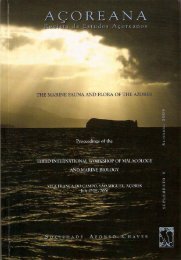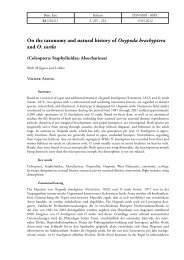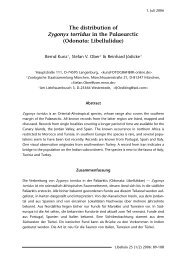(eds.) (2005). - Portal da Biodiversidade dos Açores - Universidade ...
(eds.) (2005). - Portal da Biodiversidade dos Açores - Universidade ...
(eds.) (2005). - Portal da Biodiversidade dos Açores - Universidade ...
Create successful ePaper yourself
Turn your PDF publications into a flip-book with our unique Google optimized e-Paper software.
Figura 13. Curva de acumulação (média de 100 curvas) (linha lisa) e número estimado de espécies endémicas (S) ( + 1, desvio<br />
padrão) usando o estimador não paramétrico de ocorrências Jackknife 1 com uma série de 100 simulações aleatórias, para: a)<br />
briófitos (mais as espécies endémicas <strong>da</strong> Macaronésia), b) plantas vasculares, c) moluscos e d) artrópodes.<br />
Figure 13. Accumulation curve (average of 100 random curves) (smooth line) and predicted number of endemic species (S) ( + 1<br />
s.d.) using the incidence based non-parametric estimator Jackknife 1 with 100 randomizations, for: a) bryophytes (plus<br />
Macaronesian species), b) vascular plants, c) molluscs and d) arthropods.<br />
Acari-Oribati<strong>da</strong> almost 75% of the endemic fauna<br />
is known (Jackknife1: 35.89 + 3.11 against the 27<br />
known species), for spiders (Araneae) almost 79%<br />
of the endemic fauna is known (Jackknife1: 29.22<br />
+ 2.59 against the 23 known species), but for<br />
Coleoptera only 65% of the species is known<br />
(Jackknife1: 100.60 + 10.68 against the 66 known<br />
species).<br />
The pattern for the molluscs (Fig. 13c) also<br />
shows that many more species are still to be<br />
discovered and described, as the current number<br />
of endemic species encompasses only 70% of the<br />
potential endemic richness. The high variance of<br />
the curve shows the following patterns: i) for<br />
some islands the knowledge is poor; and (ii) the<br />
rate of speciation is completely different in the<br />
several islands.<br />
For the plants there is a complete different<br />
pattern (Figs. 13a, b), according to which most<br />
endemic vascular plants have been discovered<br />
51<br />
(Diptera) essa percentagem é de 82% (Jackknife1:<br />
63.56 + 7.07 contra as 52 espécies conheci<strong>da</strong>s); para<br />
os Acari-Oribati<strong>da</strong> apenas 75% <strong>da</strong> fauna endémica é<br />
conheci<strong>da</strong> (Jackknife1 35.89 + 3.11 contra as 27<br />
espécies conheci<strong>da</strong>s); para as Aranhas cerca de 79%<br />
<strong>da</strong> fauna endémica será conheci<strong>da</strong> (Jackknife1 29.22<br />
+ 2.59 contra 23 espécies conheci<strong>da</strong>s); mas para os<br />
escaravelhos (Coleoptera) apenas 65% <strong>da</strong> fauna<br />
endémica está descrita (Jackknife1: 100.60 + 10.68<br />
contra 66 espécies conheci<strong>da</strong>s).<br />
O padrão para os moluscos (Fig. 13c) mostra que<br />
muitas mais espécies poderão ser descobertas e descritas,<br />
já que o número actual de espécies endémicas<br />
representa apenas 70% <strong>da</strong>s conheci<strong>da</strong>s. A eleva<strong>da</strong><br />
variância <strong>da</strong> curva mostra igualmente os seguintes<br />
padrões: i) para algumas ilhas o conhecimento é<br />
pobre; e (ii) a taxa de especiação é completamente<br />
diferente nas várias ilhas.<br />
Para as plantas existe um padrão completamente<br />
diferente (Figs. 13a, b), em que a maior parte <strong>da</strong>s

















